Here is the code that is based on the idea proposed by Nick. It is just to give an idea for someone who might wonder where to start to implement something like this shown below

This would let you click on any column on the left hand side table, then draws a line as your mouse moves on towards the right table, and anchors the line as soon as a column on the right hand side table is selected. It keeps a mapping between the left table row and right table row in a linked list as the mapping data model.
package sample;
import java.util.LinkedList;
import org.eclipse.draw2d.AutomaticRouter;
import org.eclipse.draw2d.ColorConstants;
import org.eclipse.draw2d.Figure;
import org.eclipse.draw2d.FreeformLayeredPane;
import org.eclipse.draw2d.FreeformLayout;
import org.eclipse.draw2d.LightweightSystem;
import org.eclipse.draw2d.MarginBorder;
import org.eclipse.draw2d.PolylineConnection;
import org.eclipse.draw2d.PolylineDecoration;
import org.eclipse.draw2d.XYAnchor;
import org.eclipse.draw2d.geometry.PointList;
import org.eclipse.swt.SWT;
import org.eclipse.swt.events.MouseEvent;
import org.eclipse.swt.events.MouseMoveListener;
import org.eclipse.swt.graphics.Point;
import org.eclipse.swt.graphics.Rectangle;
import org.eclipse.swt.layout.GridData;
import org.eclipse.swt.layout.GridLayout;
import org.eclipse.swt.widgets.Canvas;
import org.eclipse.swt.widgets.Display;
import org.eclipse.swt.widgets.Event;
import org.eclipse.swt.widgets.Listener;
import org.eclipse.swt.widgets.Shell;
import org.eclipse.swt.widgets.Table;
import org.eclipse.swt.widgets.TableColumn;
import org.eclipse.swt.widgets.TableItem;
public class GraphicTableMapper {
private static Point sourcePosition;
private static PathFigure currentPath;
private static Figure bf;
private static Canvas canvas;
private static int sourceRow;
private static int targetRow;
private static LinkedList<RowMapper> rowmapList = new LinkedList<RowMapper>();
public static void main(String[] args) {
Display display = Display.getDefault();
final Shell shell = new Shell(display);
shell.setSize(550, 500);
shell.setLayout(new GridLayout(3, false));
final Table table = new Table(shell, SWT.MULTI | SWT.BORDER
| SWT.FULL_SELECTION);
table.setLinesVisible(true);
table.setHeaderVisible(true);
final String[] titles = { "Serial Number", "Whatever" };
for (int i = 0; i < titles.length; i++) {
TableColumn column = new TableColumn(table, SWT.NONE);
column.setText(titles[i]);
}
int count = 100;// create 100 rows in table
for (int i = 0; i < count; i++) {
TableItem item = new TableItem(table, SWT.NONE);
item.setText(0, "x");
item.setText(1, "y");
item.setText(2, "!");
item.setText(3, "this stuff behaves the way I expect");
item.setText(4, "almost everywhere");
item.setText(5, "some.folder");
item.setText(6, "line " + i + " in nowhere");
}
for (int i = 0; i < titles.length; i++) {
table.getColumn(i).pack();
}
table.addListener(SWT.MouseDown, new Listener() {
public void handleEvent(Event event) {
Point pt = new Point(event.x, event.y);
TableItem item = table.getItem(pt);
if (item == null)
return;
for (int i = 0; i < titles.length; i++) {
Rectangle rect = item.getBounds(i);
if (rect.contains(pt)) {
int index = table.indexOf(item);
System.out.println("Item " + index + "-" + i);
sourcePosition = pt;
sourceRow = index;
currentPath = new PathFigure();
currentPath.setSourceAnchor(new XYAnchor(
new org.eclipse.draw2d.geometry.Point(-10,
event.y)));
currentPath
.setTargetAnchor(new XYAnchor(
new org.eclipse.draw2d.geometry.Point(
0, pt.y)));
bf.add(currentPath);
}
}
}
});
table.addMouseMoveListener(new MouseMoveListener() {
public void mouseMove(MouseEvent arg0) {
if (currentPath != null) {
((XYAnchor) (currentPath.getTargetAnchor()))
.setLocation(new org.eclipse.draw2d.geometry.Point(
0, arg0.y));
}
}
});
canvas = new Canvas(shell, SWT.None);
canvas.setBackground(shell.getDisplay().getSystemColor(SWT.COLOR_GREEN));
LightweightSystem lws = new LightweightSystem(canvas);
bf = new BaseFigure();
lws.setContents(bf);
canvas.addMouseMoveListener(new MouseMoveListener() {
public void mouseMove(MouseEvent arg0) {
if (currentPath != null) {
((XYAnchor) (currentPath.getTargetAnchor()))
.setLocation(new org.eclipse.draw2d.geometry.Point(
arg0.x > canvas.getSize().x - 5 ? canvas
.getSize().x - 5 : arg0.x, arg0.y));
}
}
});
GridData data2 = new GridData();
data2.verticalAlignment = SWT.TOP;
data2.grabExcessHorizontalSpace = false;
data2.grabExcessVerticalSpace = true;
data2.horizontalIndent = -10;
data2.widthHint = 200;
data2.heightHint = 1000;
canvas.setLayoutData(data2);
final Table table2 = new Table(shell, SWT.MULTI | SWT.BORDER
| SWT.FULL_SELECTION);
table2.setLinesVisible(true);
table2.setHeaderVisible(true);
data2 = new GridData();
data2.grabExcessHorizontalSpace = false;
data2.horizontalIndent = -10;
table2.setLayoutData(data2);
final String[] titles2 = { "Serial Number", "Whatever" };
for (int i = 0; i < titles.length; i++) {
TableColumn column = new TableColumn(table2, SWT.NONE);
column.setText(titles[i]);
canvas.redraw();
}
table2.addMouseMoveListener(new MouseMoveListener() {
public void mouseMove(MouseEvent event) {
if (currentPath != null) {
Point pt = new Point(event.x, event.y);
TableItem item = table2.getItem(pt);
if (item == null)
return;
for (int i = 0; i < titles2.length; i++) {
Rectangle rect = item.getBounds(i);
if (rect.contains(pt)) {
((XYAnchor) (currentPath.getTargetAnchor()))
.setLocation(new org.eclipse.draw2d.geometry.Point(
canvas.getSize().x - 5, event.y));
}
}
}
}
});
int count2 = 100;// create 100 rows in table 2
for (int i = 0; i < count2; i++) {
TableItem item = new TableItem(table2, SWT.NONE);
item.setText(0, "x");
item.setText(1, "y");
item.setText(2, "!");
item.setText(3, "this stuff behaves the way I expect");
item.setText(4, "almost everywhere");
item.setText(5, "some.folder");
item.setText(6, "line " + i + " in nowhere");
}
for (int i = 0; i < titles.length; i++) {
table2.getColumn(i).pack();
}
table2.addListener(SWT.MouseDown, new Listener() {
public void handleEvent(Event event) {
try {
Point pt = new Point(event.x, event.y);
TableItem item = table2.getItem(pt);
if (item == null)
return;
for (int i = 0; i < titles2.length; i++) {
Rectangle rect = item.getBounds(i);
if (rect.contains(pt)) {
int index = table2.indexOf(item);
targetRow = index;
System.out.println("Item " + index + "-" + i);
if (sourcePosition != null) {
add(event);
}
}
}
} finally {
sourcePosition = null;
sourceRow = -1;
targetRow = -1;
}
}
});
shell.open();
while (!shell.isDisposed()) {
if (!display.readAndDispatch())
display.sleep();
}
}
public static void add(Event event) {
bf.remove(currentPath);
PathFigure figure = new PathFigure();
figure.setSourceAnchor(currentPath.getSourceAnchor());
figure.setTargetAnchor(currentPath.getTargetAnchor());
bf.add(figure);
currentPath = null;
RowMapper mapper = new RowMapper();
mapper.sourceRow = sourceRow;
mapper.targetRow = targetRow;
if (!rowmapList.contains(mapper)) {
rowmapList.add(mapper);
}
}
class BaseFigure extends FreeformLayeredPane {
public BaseFigure() {
setLayoutManager(new FreeformLayout());
setBorder(new MarginBorder(5));
setBackgroundColor(ColorConstants.white);
setOpaque(true);
}
}
class PathFigure extends PolylineConnection {
public PathFigure() {
setTargetDecoration(new PolylineDecoration());
setConnectionRouter(new AutomaticRouter() {
@Override
protected void handleCollision(PointList list, int index) {
}
});
}
}
class RowMapper {
int sourceRow;
int targetRow;
@Override
public boolean equals(Object obj) {
if (obj instanceof RowMapper) {
RowMapper mapper = (RowMapper) obj;
return (sourceRow == mapper.sourceRow && targetRow == mapper.targetRow);
}
return false;
}
}
